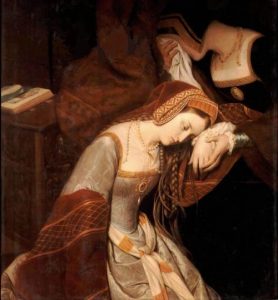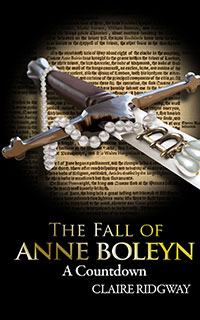
Printable Timeline – 1536 timeline PDF
January 1536
- 7th January – Death of Catherine of Aragon
- 8th January – Henry VIII, and possibly Anne Boleyn, celebrate news of Catherine’s death by dressing in yellow.
- 24th January – Henry VIII’s jousting accident at Greenwich
- 29th January – Burial of Catherine of Aragon. Anne Boleyn miscarries.
February 1536
- 10th February – Record of Henry VIII showing favour to Jane Seymour
March 1536
- March 1536 – Act for the Suppression of the Lesser Monasteries
April 1536
- 1st April – Chapuys meets with Catholic Conservatives and hears of their plans for Jane Seymour and a breach between Anne Boleyn and Thomas Cromwell
- 2nd April – John Skip preaches a controversial sermon
- 18th April – Chapuys tricked into recognising Anne Boleyn as Queen
- 23rd April – Sir Nicholas Carew elected to the Order of the Garter
- 24th April – Commissions of oyer and terminer set up for offences committed in Middlesex and Kent
- 25th April – King refers to Anne Boleyn as his “most dear and entirely beloved wife the Queen” and writes of his hope for a son.
- 26th April – Anne Boleyn charges her chaplain, Matthew Parker, with the spiritual care of her daughter, Elizabeth.
- 27th April – Writs issued summoning Parliament
- 28th April – The King’s Council recorded as meeting on a daily basis.
- 29th April – Chapuys records meetings between Cromwell and Dr Richard Sampson, an expert on canon law. Anne and Sir Henry Norris have an argument.
- 30th April – King and Queen’s visit to Calais is cancelled. Anne and Henry argue. Mark Smeaton is taken to Cromwell’s house to be interrogated. He confesses to adultery with the Queen.
May 1536
- 1st May – May Day joust. Henry VIII rushes off with Sir Henry Norris and questions him.
- 2nd May – Sir Henry Norris taken to the Tower of London, Smeaton is already there. Anne Boleyn is arrested and taken to the Tower. George Boleyn arrested at Whitehall and taken to the Tower.
- 3rd May – Archbishop Cranmer writes to Henry VIII expressing his shock on finding out about Anne Boleyn’s arrest. Anne speaks of her conversations with Norris and Sir Francis Weston.
- 4th May – Arrests of Sir Francis Weston and Sir William Brereton. Jane Boleyn, Lady Rochford, sends a message to her husband.
- 5th May – Sir Thomas Wyatt and Sir Richard Page are recorded as being imprisoned in the Tower. Sir Francis Bryan is ordered to London for questioning.
- 6th May – Date of a letter traditionally attributed to Anne Boleyn and written to Henry VIII from her prison in the Tower.
- 7th May – William Latymer, Anne Boleyn’s chaplain, searched on his arrival in England.
- 9th May – King had meetings with noblemen and gentlemen.
- 10th May – Middlesex indictment drawn up.
- 11th May – Kent indictment drawn up.
- 12th May – Trial of Norris, Smeaton, Weston and Brereton at special commission of oyer and terminer. Found guilty and sentenced to death.
- 13th May – Queen Anne Boleyn’s household is broken up. Henry Percy, Earl of Northumberland, denies a pre-contract between himself and Anne Boleyn.
- 14th May – Sir Nicholas Carew moves Jane Seymour to Chelsea. Cromwell informs Wallop and Gardiner of the Queen’s “incontinent living”.
- 15th May – Trials of Anne Boleyn and George Boleyn. Both found guilty and sentenced to death.
- 16th May – Archbishop Cranmer visits Anne Boleyn.
- 17th May – Executions of Norris, Smeaton, Weston, Brereton and George Boleyn on Tower Hill. Cranmer declares the marriage between Henry VIII and Anne Boleyn null and void.
- 18th May – Anne Boleyn’s execution is postponed.
- 19th May – Execution of Anne Boleyn within the Tower walls.
- 20th May – Betrothal of Henry VIII and Jane Seymour.
- 30th May – Marriage of Henry VIII and Jane Seymour.
June 1536
- 4th June – Jane Seymour proclaimed Queen at Greenwich.

The part of this that I find most puzzling is the swordsman from France (often referred to as being from Calais, but I find no evidence of this, as Calais was in English hands and therefore the headsman there would undoubtedly use the axe, as was common practice most areas), as most of the evidence would suggest that he was sent for before the trial, possibly even before the arrests.
Any thoughts?
The use of the axe was common practice but often crudely done by inexpert headsmen. Executions were sometimes relatively merciful for the privileged few. So executing Anne called for expert treatment. The swordsman dispatched Anne cleanly while her attention was distracted by his assistant.
I believe Anne’s execution was delayed to give the swordsman time to arrive from France.
If the indictments were only drawn up on 10, 11th May, surely the 12th May event is the grand jury calling prosecution witnessess to decide whether the indictment represents a true bill? If a true bill was returned what happened to the trial of the accused and their defence?